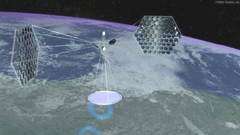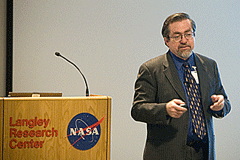Solar Power from Space
Air Date: Week of April 24, 2009

The proposed satellite would be about half a mile wide and create a beam of energy four miles wide by the time it reaches the earth. (Courtesy of: Engadget)
California utility PG&E plans to start receiving renewable energy from space by 2016. A satellite will collect solar energy and beam it back to Earth where it will be used for electricity. John Mankins is a former manager of NASA's space solar power studies. He tells host Jeff Young that such a system could provide baseload solar energy, 24 hours a day.
Transcript
YOUNG: Well, the climate change bill before Congress aims to push renewable energy sources to new heights.
Here’s a project that takes that concept quite literally. California energy utility PG&E has contracted with the private company Solaren to put solar panels in space—and beam the power back to earth. Solaren hopes to start commercial operation by 2016, pulling 200 megawatts from orbit—that’s about half what an average coal fired power plant generates.
John Mankins managed NASA’s space solar power studies before starting his own company, Managed Energy Technologies. Mankins says a solar satellite is no small undertaking.
MANKINS: It’s about a half a mile across for the transmitter and it’s on the order of ten thousand tons or approximately twenty international space stations. It would collect the sunlight and convert it into electromagnetic radiation into a beam of energy and then send it to some other locations such as a receiver on the earth.
YOUNG: Now I’m envisioning this giant laser beam of concentrated solar power shooting down to the planet, but that’s not quite right.
MANKINS: [laughing] Hopefully, no one would ever actually build such a system. The beam when it’s up in space would start out at about a half a mile across and then it would spread and be on the ground – and again everything depends on the details of the engineering – but it would spread to be approximately four miles across. You’d certainly want to take the right precautions, keep the energy density, the amount of power that’s in a square meter of the beam low enough to be safe. You’d want to geographically isolate the receiver so it wasn’t in a populated area. And you’d want to have safe guards so that planes would, for example, not be allowed normally to fly through the beam and in the event that one did inadvertently or deliberately try to fly through the beam, you’d have to be able to cut it off in a timely way so that – a sort of belt and suspenders and buttons approach - so that it was safe to start with, it’s remote, and you turn it off just in case.

John Mankins is co-founder and chief operating officer of Manged Energy Technologies and former manager of NASA’s space solar power studies and
technology research and development. (Courtesy of NASA)
YOUNG: And then, what’s the collection system like? How do you get the energy on the surface of the planet?
MANKINS: Very, very elegantly. There’s basically a simple antenna with a diode in the middle of it, and it takes incoming radio waves and converts it at very, very high efficiency, maybe 80% or 85% efficiency into voltage. Mechanically, it would look a great deal like chicken wire, like a mesh, and so even though you had this large antenna collecting energy from the solar power satellite above you, below the ground itself would still receive something like 80 percent of normal sunlight, the rain would pass though, it would not have any kind of significant impact on the sort of the ecosystem, whether it was farms or natural land beneath it.
YOUNG: So, the solar power is collected on these satellites, which is orbiting, and obviously the solar energy up there is much stronger than it is here on earth, right?
MANKINS: So up in space the average sunlight passing the earth from the sun is about 1,400 watts per square meter. And on the earth at mid summer, mid day in the desert, it’s about 1,000 watts per square meter. And on the earth, of course, you add the additional factors of normal atmospheric absorption, you add weather, you add nighttime and the overall average sunlight which is available per square meter up in space is significantly greater than that which could ever be collected on the earth.

The proposed satellite would be about half a mile wide and create a beam of
energy four miles wide by the time it reaches the earth. (Courtesy of: Engadget)
YOUNG: Now, wouldn’t the satellite also be in the shadow of the earth at some point or can you position it so that it gets sunlight all the time?
MANKINS: A lot of different cases have been looked at. The one that looks the most promising is to place these solar power satellites in what’s called a geostationary earth orbit – that’s the same orbit that used for example by broadcast satellite radio or by broadcast TV satellites. Its high above the earth, about twenty three thousand miles up, and it has an usual property - that the time it takes for a satellite to go around the earth at this particular distance is just at 24 hours. If you use the right kind of transmission technologies, this is basically solid state arrays, you could deliver power from one satellite to New York in the morning to Dallas at midday and to Los Angeles in the afternoon.
YOUNG: Is it going to be worth the investment, though?
MANKINS: If you can solve the engineering problems, if you can get solar energy from space, for on the order of ten cents a kilowatt-hour, which is highly competitive with terrestrial energy sources, space solar power has the potential to provide absolutely carbon neutral energy to billions of people 24/7. So those would be problems definitely worth addressing.
YOUNG: John Mankins is an expert in space based solar power. He’s with Managed Energy Technologies. Thank you very much for speaking with us.
MANKINS: It’s been my pleasure. Thank you.
Links
Living on Earth wants to hear from you!
Living on Earth
62 Calef Highway, Suite 212
Lee, NH 03861
Telephone: 617-287-4121
E-mail: comments@loe.org
Newsletter [Click here]
Donate to Living on Earth!
Living on Earth is an independent media program and relies entirely on contributions from listeners and institutions supporting public service. Please donate now to preserve an independent environmental voice.
NewsletterLiving on Earth offers a weekly delivery of the show's rundown to your mailbox. Sign up for our newsletter today!
 Sailors For The Sea: Be the change you want to sea.
Sailors For The Sea: Be the change you want to sea.
 The Grantham Foundation for the Protection of the Environment: Committed to protecting and improving the health of the global environment.
The Grantham Foundation for the Protection of the Environment: Committed to protecting and improving the health of the global environment.
 Contribute to Living on Earth and receive, as our gift to you, an archival print of one of Mark Seth Lender's extraordinary wildlife photographs. Follow the link to see Mark's current collection of photographs.
Contribute to Living on Earth and receive, as our gift to you, an archival print of one of Mark Seth Lender's extraordinary wildlife photographs. Follow the link to see Mark's current collection of photographs.
 Buy a signed copy of Mark Seth Lender's book Smeagull the Seagull & support Living on Earth
Buy a signed copy of Mark Seth Lender's book Smeagull the Seagull & support Living on Earth

